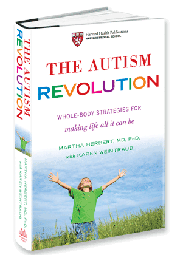What in the environment can contribute to autism or its manifestations or challenges? Note that the question is not what causes autism but what might contribute to it.
Here are some things that have been proposed.
Too much:
- Too much of things that are needed but not that much or not the right kinds. Examples:
- nutrients that cause problems or become toxic when their levels are too high (e.g. folate, zinc)
- stimulation: too much information that is coming in too fast or at a level too advanced to be processed so it is experienced as overwhelming
- microbiome: overgrowth of some opportunistic and/or harmful microorganisms (e.g. gut bugs) at the expense of others
- Exposure to microorganisms
- Too much of things that should not be there at all. Examples:
- toxic chemicals or heavy metals that play no role in human metabolism
- Emerging science of low dose toxicology: very low doses can cause problems at levels far lower than what can kill you
- Review article “Is everything we think we know about chemical toxicity wrong?
- toxic byproducts of normal metabolism that build up because the body’s mechanisms for eliminating them adequately are not working properly
- abuse or neglect (e.g. orphanages, some adoptees)
Not enough:
- Not enough nutrients
- low nutrient density food (junk food, food refined in a way that depletes it of nutrients)
- this “food” stimulates inflammation with empty calories while simultaneously being bereft of nutrients that would help the body fight inflammation
- nutrition that would be adequate for an “average” person but not for someone whose needs are higher (because of genetics, illness, stress or environmental interference with metabolism)
- Not enough support and nurturance / emotional disconnection
- This point hearkens back to the now infamous “refrigerator mother theory” that blamed autism on cold mothers
- Not enough maternal-infant bonding
- This point may raise hackles due to the heritage of the “refrigerator mother theory” but a physiology x environment interaction where an infant undergoing physiological stress may have a hard time eliciting or receiving enough comfort and the resultant stress may contribute to the physiological problems.
- Not enough learning and stimulation
Distortion:
- Macro-structural distortion
- Birth stress. From an osteopathic point of view, structural torques created by either position in the womb or torques and strains to the head and body induced during the birth process may compromise cranial nerve supply or other nerve or vascular openness or dynamic structural integration. Such compromises may predispose to physiological problems such as infant colic or ear infections that lead to compromised sleep (that affects cognition and immune system plus more) and recurrent infections (that can lead to repeated courses of oral antibiotics that alter gut microbial ecology) that feed into physiological cascades that degenerate resiliency.
- Micro-structural distortion
- An example is lipid peroxidation from environmentally-induced oxidative stress, that stiffens cell membranes and impedes optiimal function of membrane receptors and channels.
When
- Before conception: Impact of parental health status on vulnerability to genetic damage, gene mutations, level of inflammation and oxidative stress –
- During pregnancy: Similar considerations to before conception
- After birth: early influences that influence physiology and gene expression
How
Through either support of or damage to:
- Epigenetics: Alteration of gene expression by environment
- Alteration of immune and metabolic processes and how they are regulated
- Nutritional stores that provide substrate for efficient biochemical and physiological function (fortification or depletion)
- DNA repair mechanisms
- Mitochondrial structure and function
Is autism (or subgroups thereof) an environmental illness?
- What is environmental illness? A set of symptoms that arise due to underlying metabolic and immune processes altered by a “perfect storm” of too much environmental stress and not enough resiliency
- Why is environmental illness controversial? Because the symptoms are variable between individuals and also include what many skeptics derive as a “vague” array of psychological as well as physical complaints
- Why would environmental illnesses be highly variable and heterogeneous? Because it is the outcome of a combination of complex genetic individuality interacting with immense variation in what combinations of toxic exposures, nutritional shortfalls and stressors people experience.


